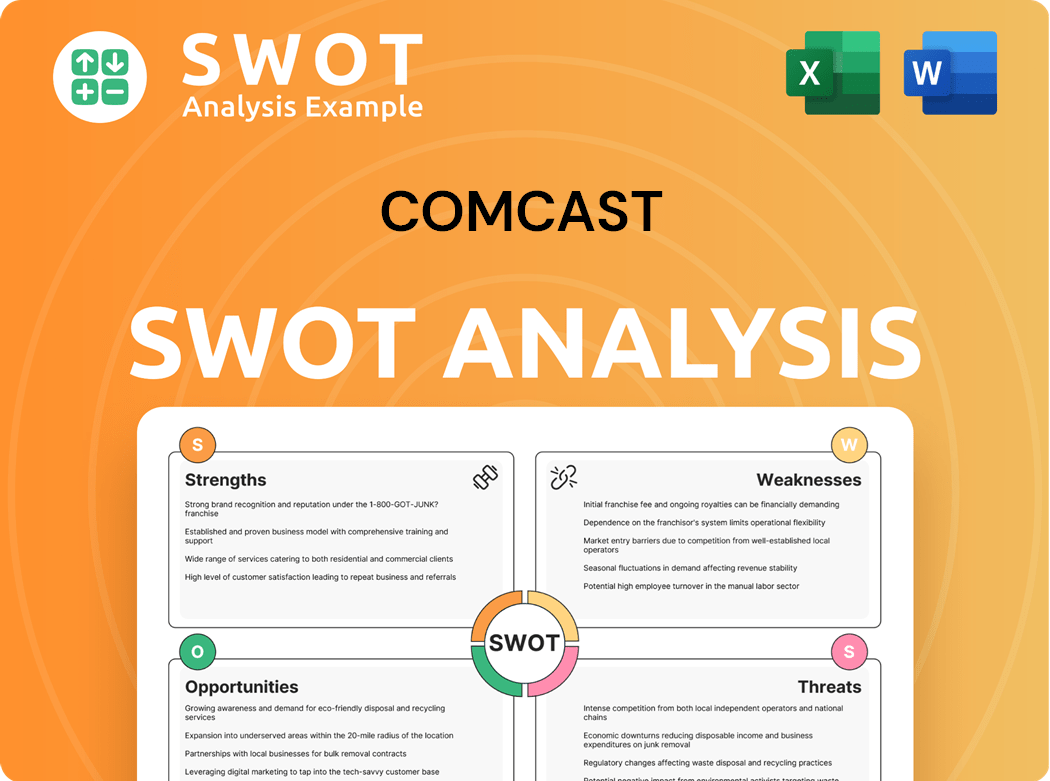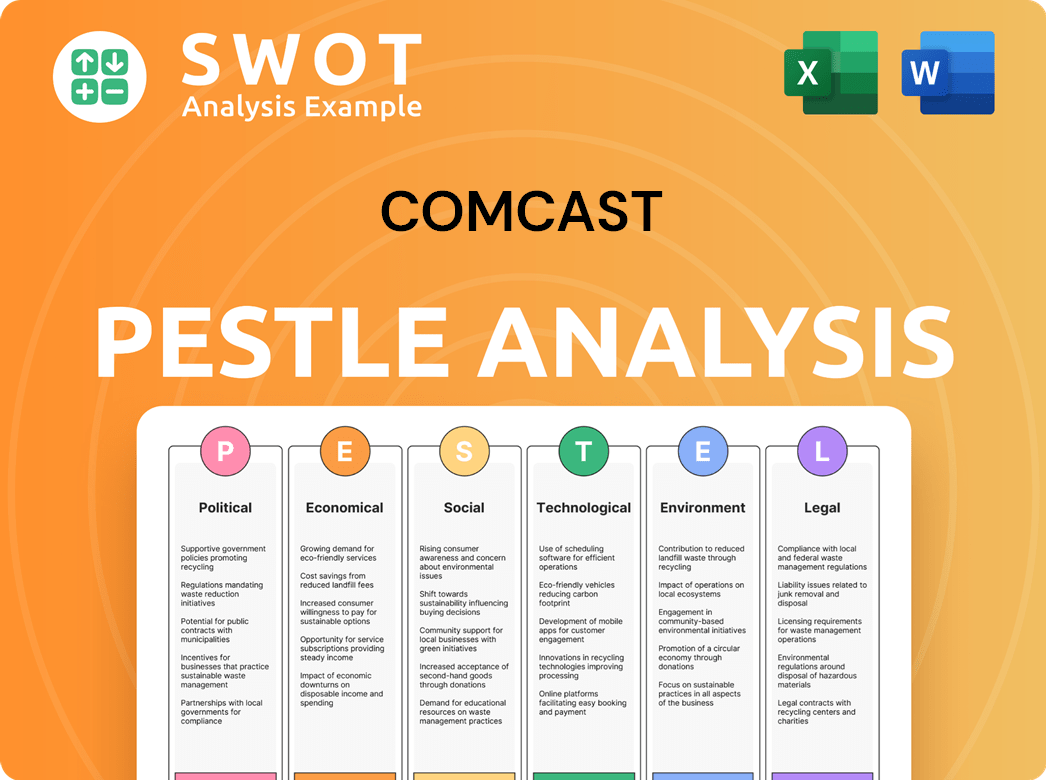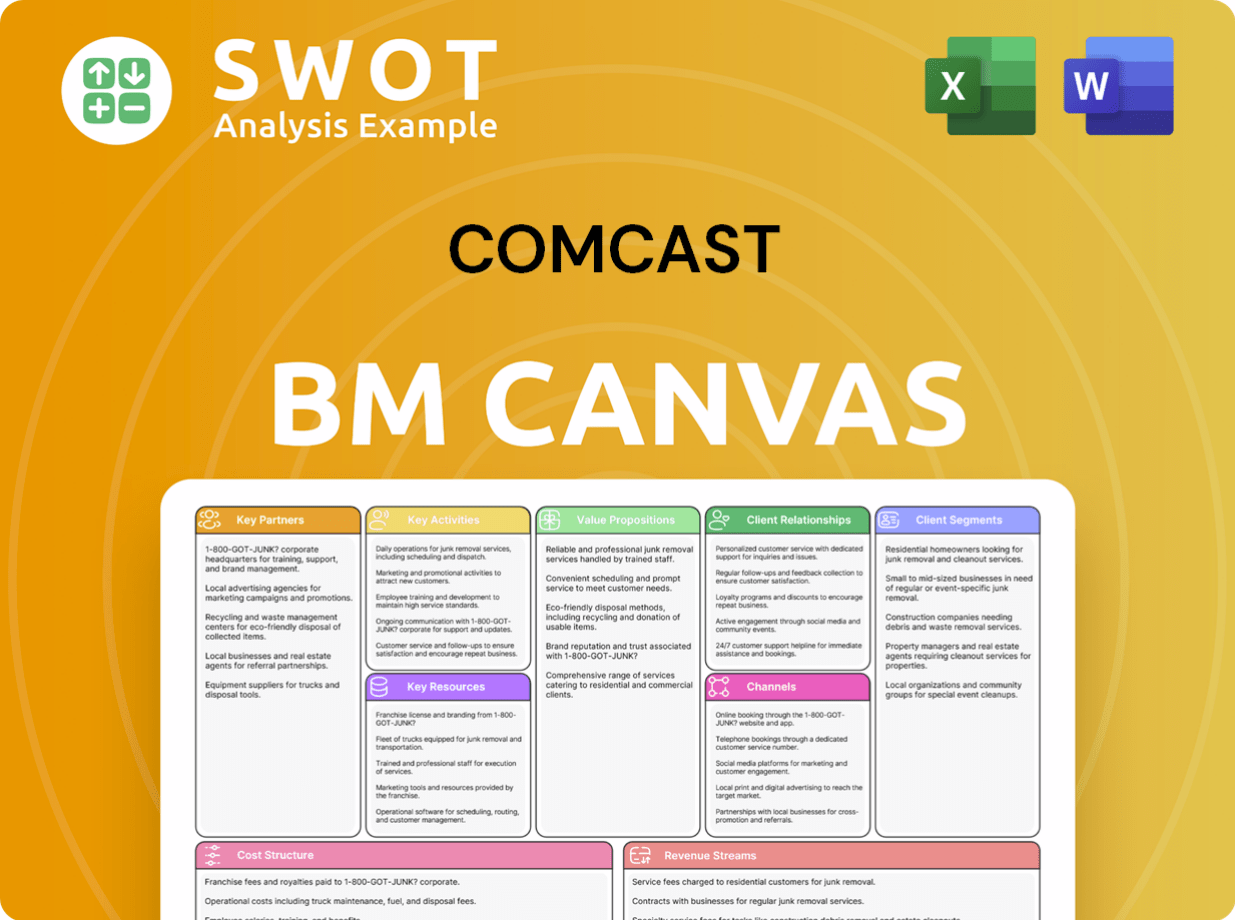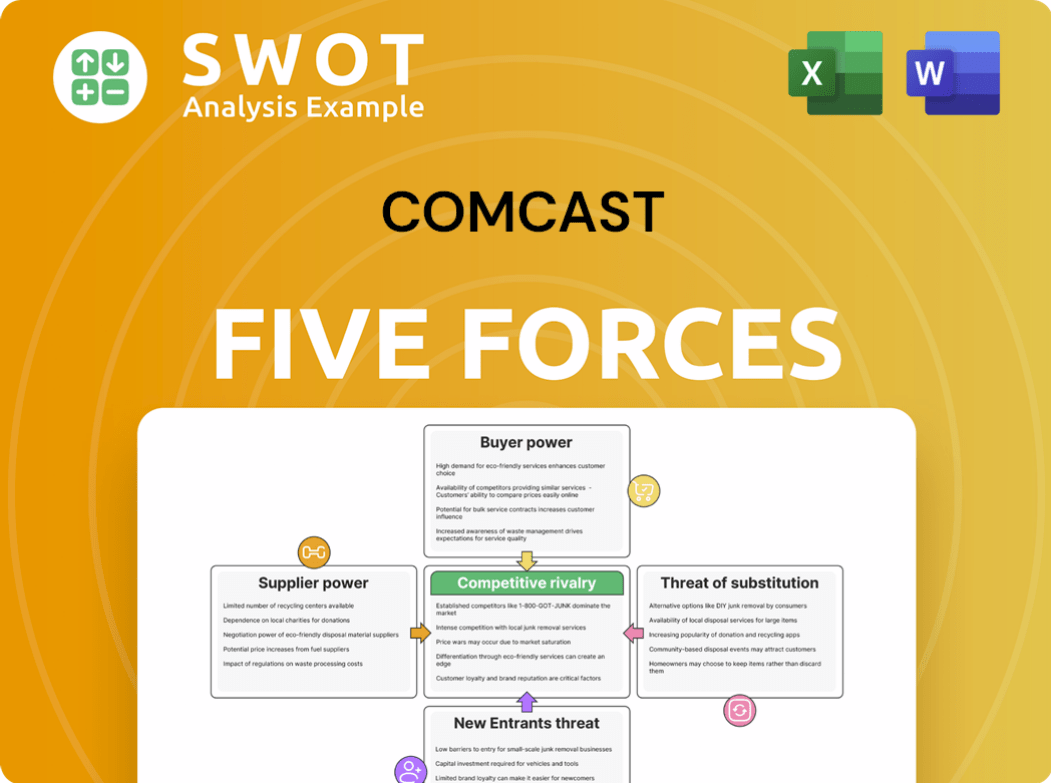Comcast Bundle
Who Does Comcast Serve in Today's Digital World?
In the dynamic media and technology landscape, understanding Comcast SWOT Analysis is crucial for grasping its strategic position. The evolution of companies like Comcast, from cable providers to multifaceted service giants, mirrors the shifting preferences of its customer base. Identifying the Comcast customer profile and its target market is key to understanding its current and future success.

This deep dive into Customer demographics Comcast will explore the company's Comcast audience and how it segments its market to meet diverse needs. We'll analyze Comcast user base characteristics, geographical distribution, and service preferences, providing insights into how Comcast adapts to consumer behavior and technological advancements. This analysis will help determine Who are Comcast's ideal customers and what factors influence Comcast customer buying behavior.
Who Are Comcast’s Main Customers?
Understanding the primary customer segments is crucial for analyzing the business model. The company caters to a diverse audience, primarily divided into residential consumers (B2C) and businesses (B2B). This segmentation allows for tailored marketing and service strategies, enhancing customer engagement and satisfaction.
The main customer groups and core demographics for its Xfinity brand are categorized by factors such as age, gender, and income. Analyzing these segments helps to understand the company's market position and identify growth opportunities. Comcast's approach to its customer base is a key aspect of its overall strategy.
The company's ability to adapt and cater to these distinct segments is a key factor in its market performance and customer retention. This approach allows the company to effectively address the specific needs and preferences of each group.
For residential customers, the company offers cable television, high-speed internet, and telephone services under the Xfinity brand. The focus is on providing integrated services to meet the needs of households. The company reported 30.97 million domestic residential connectivity and platforms customer relationships in Q1 2025.
Comcast Business provides broadband, voice, and video services to businesses. This segment has shown consistent growth, with revenue increasing 3.7% to $2.496 billion in Q1 2025. The company aims to serve 3.5 million businesses in the coming year, focusing on small and medium enterprises (SMEs).
The Comcast customer profile includes a wide range of demographics. This includes factors like age, income levels, and geographic location. This diversity is a key characteristic of the company's Comcast target market. Understanding these demographics is crucial for effective marketing strategies.
The company employs various market segmentation strategies to target its Comcast audience effectively. This involves dividing the market into different groups based on their needs and preferences. This approach allows for tailored services and marketing campaigns. For more insights, explore the Marketing Strategy of Comcast.
The company's overall customer relationships for Connectivity & Platforms decreased by 228,000 to 51.4 million in Q1 2025. Domestic wireless line net additions were 323,000 in Q1 2025. 'Connectivity & Platforms' is projected to generate approximately $79 billion in revenues in FY2025, representing 63% of total revenues.
- The company serves a broad customer base.
- Market segmentation is a key strategy.
- Revenue is driven by Connectivity & Platforms.
- The company focuses on both residential and business customers.
Comcast SWOT Analysis
- Complete SWOT Breakdown
- Fully Customizable
- Editable in Excel & Word
- Professional Formatting
- Investor-Ready Format

What Do Comcast’s Customers Want?
Understanding the needs and preferences of the Comcast customer base is crucial for effective marketing and service delivery. The Comcast customer profile is diverse, but key drivers consistently emerge. Customers seek reliable, high-speed internet and a variety of entertainment options.
Comcast's ability to meet these needs directly impacts customer satisfaction and retention. The demand for high-bandwidth activities like streaming and gaming continues to rise, influencing Comcast's target market strategies. Addressing customer pain points, such as simplifying bundles and providing transparent pricing, is also essential.
Comcast's focus on customer needs is reflected in its product offerings and marketing strategies. By understanding the Comcast audience and their preferences, the company can tailor its services to meet evolving demands.
The demand for high-speed internet is skyrocketing. Network traffic has dramatically increased, with the number of connected devices in homes rising by 40% over the last four years.
Customers show a strong preference for high-bandwidth activities. The top five biggest internet traffic events in history all occurred in the last two months of 2024, driven by NFL streaming and large game downloads.
Mobile connectivity is a key preference. 90% of smartphone data usage occurs over Wi-Fi, which carries ten times the data of all cellular networks combined.
Customers want simpler bundles and more transparent pricing. Comcast has introduced new broadband pricing plans with five-year price locks in April 2025 to address these concerns.
Marketing is tailored to highlight family-friendly content packages, sports packages, and high-speed internet capabilities for gamers and online professionals.
Comcast is integrating AI into network operations to enhance efficiency and customer experience.
Comcast's approach to understanding and meeting customer needs is multifaceted. By focusing on these areas, Comcast aims to maintain a strong position in the market and improve customer satisfaction. For more details on Comcast's customer demographics and strategies, further research is recommended.
Comcast PESTLE Analysis
- Covers All 6 PESTLE Categories
- No Research Needed – Save Hours of Work
- Built by Experts, Trusted by Consultants
- Instant Download, Ready to Use
- 100% Editable, Fully Customizable

Where does Comcast operate?
The geographical market presence of Comcast is predominantly within the United States. The company's services are available across various areas, including urban, suburban, and rural regions. Comcast tailors its offerings to meet the unique needs of customers in different locations, reflecting its understanding of the diverse needs within its Comcast customer profile.
In fiscal year 2024, the United States generated the majority of Comcast's revenue, representing 77.78% of its total revenue. This highlights the significant reliance on the U.S. market for its financial performance. Comcast's strategic focus on expanding its network and services in the U.S. is evident in its investment decisions and market strategies.
Comcast is actively working to broaden its reach, particularly in areas that are underserved or newly developed. This expansion includes both organic growth and strategic initiatives to connect more homes and businesses to its network. Understanding the geographic distribution of Comcast customers is key to its growth strategy.
Comcast is expanding its network to reach more homes and businesses, especially in rural and newly developed areas. In December 2024, Comcast completed a network expansion in Minnesota, connecting over 2,400 new homes and businesses across six cities. Additional expansions are underway in Chanhassen and Nowthen, Minnesota, with completion expected in 2025.
Comcast has been awarded $61 million from the Commonwealth of Pennsylvania to bring gigabit-plus internet speeds to unserved or underserved homes and businesses across 158 municipalities. This funding supports Comcast's efforts to enhance its infrastructure and expand its service offerings.
Comcast aims to add 1.2 million homes to its existing 63 million by 2025. This expansion focuses on its 1-gigabit product, demonstrating a commitment to increasing its customer base and providing high-speed internet services. This is a key component of how Owners & Shareholders of Comcast view the company's growth.
Internationally, Comcast operates Sky Group, providing satellite TV and broadband internet services in the United Kingdom, Germany, and Italy. Comcast Advertising is expanding its international business, including a new Media Solutions division, to streamline media buying across its portfolio in the U.S., UK, and Europe.
Comcast Business Model Canvas
- Complete 9-Block Business Model Canvas
- Effortlessly Communicate Your Business Strategy
- Investor-Ready BMC Format
- 100% Editable and Customizable
- Clear and Structured Layout

How Does Comcast Win & Keep Customers?
Comcast's customer acquisition and retention strategies are multifaceted, designed to attract and keep a diverse customer base. The company leverages a blend of digital marketing, content marketing, and social media to reach potential customers. Data-driven marketing plays a crucial role, enabling Comcast to adapt its strategies based on consumer trends and behaviors, ensuring efficient resource allocation and effective customer engagement.
The company focuses on both attracting new customers and retaining existing ones through various initiatives. This includes targeted advertising, attractive bundling options, and efforts to improve customer experience. Comcast's approach is dynamic, constantly evolving to meet the changing needs and preferences of its broad Comcast customer profile.
Comcast's strategies are designed to appeal to a wide range of Comcast audience segments. By understanding the diverse needs of its Comcast user base, the company aims to deliver tailored services and experiences that foster customer loyalty and drive business growth. These strategies are regularly updated to remain competitive in the rapidly changing telecommunications industry. To understand the financial aspects, you can read more about it in the Revenue Streams & Business Model of Comcast.
Comcast uses targeted advertising on social media and search engines to reach specific demographics and interests. This approach ensures that marketing messages are delivered to the most relevant potential customers. Traditional media, such as TV commercials, also remain part of the strategy.
Bundling services, particularly with Xfinity and NBCUniversal offerings, creates attractive packages to boost customer acquisition. For example, Xfinity Mobile and Comcast Business Mobile offer competitive pricing to attract new customers. Integrating mobile services into broadband packages also accelerates wireless growth.
Comcast aims to make every customer interaction positive, offering incentives like discounted bundled packages and customer referral awards. The company emphasizes quick service response times and personalized configurations. Business plans offer 24/7 support and dedicated account representatives.
Comcast is investing in mobile services and cheaper internet plans tailored for streaming to counter subscriber losses. The introduction of Xfinity StreamSaver, a streaming bundle of Peacock, Netflix, and Apple TV+, provides significant annual savings, enhancing customer value.
Comcast faces challenges in retaining customers, as seen in Q1 2025 with losses of 199,000 broadband customers and 427,000 TV subscribers. The company is actively working to counter these trends by investing in mobile services and cheaper internet plans tailored for streaming. These strategies are intended to attract and retain customers by offering competitive pricing and enhanced services, addressing the Comcast target market's evolving needs. The company is also focused on improving customer satisfaction through better service and support, which is crucial for long-term retention. The focus on customer satisfaction is evident in the initiatives to provide faster response times and personalized configurations. Comcast customer age range, income levels, and geographic distribution are diverse due to the wide range of services offered across various locations.
Comcast leverages digital marketing strategies, including social media and search engine advertising. These efforts are designed to reach specific demographics and interests, ensuring that marketing messages are targeted and effective. Data analytics are used to refine these strategies.
Content marketing plays a vital role in attracting and retaining customers. Comcast creates valuable content that engages its audience, providing information and insights relevant to their interests. This helps build brand loyalty and drive customer acquisition.
Social media marketing is a key component of Comcast's strategy. The company uses various social media platforms to connect with customers, share updates, and promote its services. This direct engagement enhances customer relationships and brand visibility.
Bundling services, particularly with Xfinity and NBCUniversal offerings, is a core acquisition strategy. These packages offer attractive value propositions, encouraging customers to choose Comcast for multiple services. This increases customer lifetime value.
Comcast utilizes customer referral programs to incentivize existing customers to recommend the services to others. These programs help acquire new customers through trusted recommendations, enhancing the acquisition efforts and increasing customer satisfaction.
Providing excellent customer service and support is a key retention strategy. Comcast focuses on quick response times, personalized configurations, and 24/7 support for business customers. These efforts aim to improve customer satisfaction and reduce churn.
Comcast Porter's Five Forces Analysis
- Covers All 5 Competitive Forces in Detail
- Structured for Consultants, Students, and Founders
- 100% Editable in Microsoft Word & Excel
- Instant Digital Download – Use Immediately
- Compatible with Mac & PC – Fully Unlocked

Related Blogs
- What are Mission Vision & Core Values of Comcast Company?
- What is Competitive Landscape of Comcast Company?
- What is Growth Strategy and Future Prospects of Comcast Company?
- How Does Comcast Company Work?
- What is Sales and Marketing Strategy of Comcast Company?
- What is Brief History of Comcast Company?
- Who Owns Comcast Company?
Disclaimer
All information, articles, and product details provided on this website are for general informational and educational purposes only. We do not claim any ownership over, nor do we intend to infringe upon, any trademarks, copyrights, logos, brand names, or other intellectual property mentioned or depicted on this site. Such intellectual property remains the property of its respective owners, and any references here are made solely for identification or informational purposes, without implying any affiliation, endorsement, or partnership.
We make no representations or warranties, express or implied, regarding the accuracy, completeness, or suitability of any content or products presented. Nothing on this website should be construed as legal, tax, investment, financial, medical, or other professional advice. In addition, no part of this site—including articles or product references—constitutes a solicitation, recommendation, endorsement, advertisement, or offer to buy or sell any securities, franchises, or other financial instruments, particularly in jurisdictions where such activity would be unlawful.
All content is of a general nature and may not address the specific circumstances of any individual or entity. It is not a substitute for professional advice or services. Any actions you take based on the information provided here are strictly at your own risk. You accept full responsibility for any decisions or outcomes arising from your use of this website and agree to release us from any liability in connection with your use of, or reliance upon, the content or products found herein.